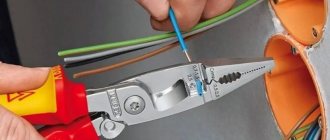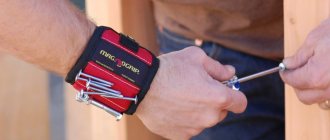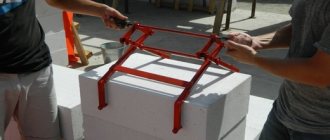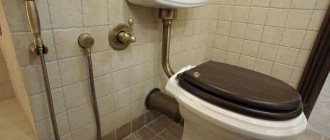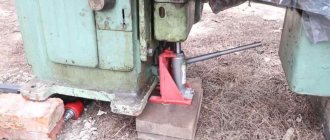For everyone who doesn’t know, a nut splitter is a simple device that helps deal with any nuts.
The main purpose of a nut splitter is to preserve the threads and get rid of the nut.
List of materials
- drill 10 mm;
- bolt M12;
- long nut M12;
- vehicle tie rod end.
Production process
It is necessary to saw off all unnecessary parts from the steering tip.
Then we drill the hole we need in the middle with a drill with a diameter of 10 mm.
We attach the M12 nut to the base of the steering rod by welding. It is necessary to weld so that the holes match. To make it easier, insert something round to center them.
To give an aesthetic appearance, you can sand the resulting product.
This is interesting: How to use a gas cylinder as a smokehouse
Next, we make a part that will split our nuts. Take a piece of shank from a 10 mm drill. We cut off the excess from the drill and leave 35 mm and sharpen it.
We insert the drill inside the nut and screw the bolt there. The bolt must have a hardness of more than 8.8 units for a longer service life.
- Application of the resulting homemade product
- Our homemade product is used when the nut is in an inaccessible place for an angle grinder.
- In the example, you saw that a self-made device copes perfectly with a soured nut and does not violate the integrity of the thread.
- Good luck to everyone in your endeavors!
Source: https://notperfect.ru/svoimi-rukami/gajkokol-iz-metalloloma-svoimi-rukami.html
Types of nutbreakers
Mechanical manual
Suitable for car enthusiasts and household needs. The forces generated by the tool are enough to unscrew a soured bolt or stud. It is inexpensive, sometimes they make it themselves. Sold in stores separately or as part of sets of 2-3 items. Prices for a mechanical nut breaker start at 200 rubles. and reach up to 3000. The main disadvantage of the device is that working with it requires significant physical strength, and therefore the maximum diameter of the nuts is limited to 27 mm.
The design and operating principle are extremely simple. The tool is a steel ring of sufficient thickness and rigidity with a welded handle pipe through which the cutting element enters the ring area.
The cutter is connected to a bolt that pushes it forward through a steel ball bearing.
Hydraulic compact
Such a tool looks little different from its mechanical counterpart. During the operation of a hydraulic nut cutter, the screw is also turned, but the pressure is not transmitted directly to the cutting surface, but through a hydraulic booster, due to which the person strains less. A compact hydraulic nutbreaker develops forces of up to 5 tons and costs in the range of 2000–7000 rubles.
Hydraulic manual
In appearance, a hydraulic manual nutbreaker is similar to a plastic grease gun. The tool has two handles - a holder and a hydraulic lever. The piston system is responsible for increasing the force in the device, thanks to which it is possible to obtain a significant 35 tons. A hydraulic nut cutter costs more than 9,000 rubles; there are models for 30,000. Such nut cutters find their use in construction and other professional fields. The undoubted advantages are high power and independence from external energy sources.
Hydraulic with separate drive
This type of nut cutter is connected to an external power source. Pumps that create pressure operate on electricity, gasoline or the muscular power of a worker. The hydraulic nut-breaker develops enormous force with the help of an external drive; nuts up to M36 are cut inclusive.
Application – construction, railway transport, industry.
The price of the nut cutter itself is about 15,000. The cost of the tool together with the drive reaches 500,000 rubles. Choosing an electric pump saves about half this amount, but makes the installer dependent on the network.
Nut cutter: soured nuts are no longer a problem
April 26, 2018
In service workshops and amateur practice, problems often arise with soured nuts that cannot be removed with wrenches. To solve the problem, a special tool is used - a nut cutter. Read the article about the types and design of nut cutters, their selection and proper use.
What is a nut cutter
A nut cutter (nut breaker, nut pick) is a special tool designed for mechanical destruction of nuts, threaded couplings and other threaded fasteners when it is impossible to dismantle them by other means.
Threaded connections are characterized by the problem of souring, as a result of which the nut, coupling or other part cannot be unscrewed along the thread from the mating part.
This problem is a consequence of the design features of the threaded connection: in the thread between two parts there is always an air gap (spiral groove), in which water and various aggressive substances can accumulate.
Because of the water in the gap, corrosion processes actively occur, and over time, the resulting metal oxides firmly connect the threaded parts - the nut or coupling sours (“sticks”), and it is no longer possible to unscrew it with a wrench or other tool.
Similar problems arise when a nut or bolt is deformed, causing the fastener to jam and become inaccessible to conventional tools.
To connect soured threaded connections, you can use various chemical compounds that dissolve or soften oxidation products.
A deformed nut and bolt can only be removed by applying considerable force to them.
However, in most cases, the task of preserving the nut is not worth it, so to quickly remove nuts, couplings or other soured parts, it is better to use a special tool - a nut cutter or a nut hammer.
- 1 250 ₽
- 290 ₽
- 400 ₽
- 770 ₽
- 610 ₽
- 500 ₽
- 950 ₽
- 1 340 ₽
Types and design of nut cutters
Nut cutters available on the market today are divided into two large groups based on the type of drive:
- Mechanical;
- Hydraulic.
Mechanical nutbreakers are the simplest and cheapest tools that can be used to break nuts ranging in size from 3 to 27 mm. In the simplest case, the tool consists of three parts:
Mechanical Nut Cutter Device
- Housings with lug nut;
- Cutter (or chisel);
- Threaded cutter drive.
The housing can have various design solutions:
- Ring (with eye) straight or inclined;
- Single-sided (with C-shaped grip) straight or inclined.
In the first case, the body is conventionally divided into two parts - the eyelet for the nut and the handles. A channel is drilled along the longitudinal axis of the handle, in the upper part of which a thread is cut.
In the lower part, on the side of the transition to the eye), a cutter is located in the channel, and a bolt with a spherical end is screwed into the thread. The bolt rests on the cutter and, when rotated, ensures its translational movement.
In this case, the slow translational movement of the cutter is converted into a significant force (the same effect underlies the operation of mechanical jacks), which ensures that the cutter cuts the nut.
In the second case, instead of an eye, the body has a C-shaped grip, which in some cases makes work easier, allowing you to quickly put on and remove the tool from the nut.
Both types of housing can be straight or angular. The straight body is simple in design, but it is not always convenient for working with nuts that protrude over large flat surfaces.
In an angular housing, the eye is positioned at a slight angle to the handle, this solution makes it easier to break the nut that protrudes over large flat surfaces and in confined spaces.
The cutter (or cutters) of the nut cutter are made of alloy steel; often the working edges of the cutters are made in the form of carbide inserts to increase their operating efficiency and service life.
Powerful hydraulic nut cutter Hydraulic single-sided nut cutter with movable cutter
Hydraulic nutbreakers are an improved tool that uses the force developed by the fluid during its compression to cut nuts (this effect is used in jacks and in hydraulic systems in general).
In general, the design of the tool is similar to that described above, however, in its handle there is a hydraulic cylinder that drives the cutter.
Such nut cutters can create a force of several tons, which makes it possible to work with large nuts and high strength classes.
Hydraulic nut cutters can have two types of drive:
- Manual - using a screw or handle on the tool body;
- From the pump - using a separate hydraulic pump (pump), to which the tool is connected by a pipeline.
Tools of the first type are simpler and self-contained; tools of the second type have increased power and can only be operated with a specialized hydraulic pump. In any case, hydraulic nutbreakers for the most part are professional tools that have a high cost.
Types and characteristics of nut breakers
Nut cutters differ in some design features - the number and location of cutters, the presence and functionality of stops, and completeness.
The tool can use cutters and stops in various combinations:
Mechanical nut cutter with moving cutter Mechanical nut cutter with two cutters
- One movable cutter without stops (the counter part of the eye acts as a stop);
- One fixed cutter and a movable stop (the cutter is fixed on the part of the eye or grip opposite to the stop);
- Two incisors - one fixed and one movable;
- One movable cutter and one adjustable stop (with its help you can set the size of the nut and adjust the tool to the specific position of the fastener).
The first and third solutions are most often used on lug nut cutters, the second and fourth on C-grip tools.
This tool has the following main characteristics:
- Nut size;
- Developed effort;
- Strength classes of nuts.
Mechanical nut cutters are typically used to cut nuts ranging from 3mm to 27mm, while hydraulic tools can cut nuts up to 50mm or larger. At the same time, mechanical devices develop a force of hundreds of kilograms, and hydraulic ones - from 5 to 35 tons.
As for the strength of nuts, mechanical nutbreakers can work with nuts of strength classes from 4 to 10, made from various grades of carbon and alloy steel without additional processing.
A hydraulic tool can destroy nuts of almost all strength classes, and in some cases it is also possible to work with heat-treated (hardened) parts.
The ability to work with nuts of different strengths depends both on the force developed and on the material used to make the cutter - all this is usually indicated in the instructions for a specific tool.
Choosing the right nut cutter and how to use it
When choosing a nut driver, you should take into account the size of the nuts you will have to work with and the intensity of use of the tool.
The most widely available on the market are mechanical tools for nut sizes 3-9, 7-9, 9-12, 12-16, 16-22 and 22-27 mm; hydraulic nut cutters are available for a wider range of nuts, up to 50 mm (thread to M36).
If you often have to work with fasteners of different sizes, then you should pay attention to tool kits that cover the entire size range of nuts.
If you rarely have to deal with soured or damaged nuts, then an inexpensive mechanical tool will be your best choice. Otherwise, it makes sense to purchase a hydraulic nut cutter (or kit) - it will save a lot of time and effort.
If you have a specialized hydraulic pump, it will be justified to select the appropriate nut-breakers, but in this case it is necessary to pay attention to the type and size of the connecting fittings. This information must be specified in the instructions.
The tool is quite easy to use.
To dismantle a part, the nut cutter must be placed on the nut, having previously adjusted the position of the cutter or stop in accordance with its size, and make the cut by rotating the screw or applying pressure to the hydraulic cylinder.
In this case, the working edge of the cutter should be located along the axis of the nut or at a certain angle that can be adjusted. As the cutter moves, it cuts through the wall of the nut, after which it can be easily removed.
When working with nut breakers, safety precautions should be observed, as the tool develops significant force, which can lead to injuries (including eye injuries due to flying fragments of nuts made of some types of steel). Only correct operation of the tool leads to the desired result and ensures work without injury.
Purpose and principle of operation of a nut cutter
The nut hammer is intended for removing nuts that are stuck, rusted or with broken threads. In this case, the bolt remains undamaged. Different models of nut cutters are widely used in auto mechanics, construction of buildings and engineering structures, fastening of industrial equipment, power plants...
According to the principle of operation, the tool is similar to a chisel, only it cuts the nut, creating constant pressure of the cutting edge on its surface, without impact. The ring holder ensures a secure grip of the fastener.
Device and characteristics
Regardless of the specific model, the nut has the following parts: body, drive, cutting element.
The body of the nut splitter, like a spanner wrench, is installed on the nut, for which it is made in the form of a half or full ring. The diameter of the hole determines which nuts the tool can work with. The handle with the screw in mechanical models also serves as a stop for the cutting part. The drive creates the force necessary for cutting metal.
Due to the fact that each tool has an acceptable range of nuts, it makes sense to take a set of nut breakers when purchasing. So the desired option will always be available.
Material
The main material is steel, and for the cutting component - more durable and wear-resistant alloy metal grades. The handles are covered with chemical-resistant rubber for greater comfort and a secure grip, even with oily hands.
Dimensions and weight
The dimensions and weight of the nutbreaker vary from model to model and depend on the working range of nut diameters. Simple mechanical devices about 100 mm long weigh approximately 200 g. Hydraulically reinforced nut splitters for nuts up to 24 mm can weigh up to 4 kg. In terms of dimensions, this hydraulic nut will be similar to a car jack.
Assembly instructions
You can start developing a homemade universal gander-type puller yourself.
The gander manufacturing technology is as follows:
- Bend the rod in an “G” shape so that the length of the short arm is 5 cm.
- Cut a thread at the end of the long arm.
- Select the right size nut for it.
- Make a wedge from the plate.
- Cut a hole in the plate for the support pin.
- On the thickened part of the wedge, opposite the slot, cut a hole for the bent rod.
- Insert the long arm of the L-shaped piece into the hole made.
- Screw the nut onto the thread.
- Place the plate in the gap between the eye and the support.
- Place the short arm of the rod against your finger.
- Tighten the nut until the pin is pressed out.
Tips for choosing
To select the optimal nut breaker, they focus on the list of future tasks. The buyer must be clearly aware of the difference between domestic and industrial use, understand the diameters of the fasteners and understand what forces are required from the tool, and whether a mechanical drive will be sufficient. For those who purchase a nut cutter for household tasks, it is recommended to adhere to the following rules:
- Before purchasing, dimensions are taken from the nuts to be removed; it is also important to measure the free working area around the nut if it is limited in some way. This way you can choose the right screw.
- If the tool will be used very rarely, for example, the need to cut off fasteners is one-time in nature, and when the nut will be needed again is unknown, it is better to buy an economy class product. In this category, STAB and FIT are considered worthy representatives.
- It often makes sense to choose a set of several tools, especially if the overpayment is small. This type of purchase is more forward-looking.
- You should avoid purchasing nutbreakers from unknown ones; as a rule, they better monitor the quality of their products.
How to make a nut with your own hands
If you have the tools and the proper skill, you can make a nut cutter with your own hands.
List of tools:
- welding machine;
- bench vice;
- lathe (optional);
- drill and bit;
- grinder and grinding wheel for metal;
- threading device;
- grinder.
First, find the base for the nut cutter ring. Unnecessary spare parts with thick steel circles, for example, a steering wheel tip, are suitable. If these are not available, the element is made from metal round timber on a lathe. The center of the hole being made is mixed by placing a small plate under one of the cams. The hole size is checked against the maximum nut that the tool will pierce. When a recess of sufficient diameter has been obtained from the round timber, a thick ring is cut off. Its width should be enough to weld the handle and drill a through hole to accommodate the cutter.
A hollow steel rod is suitable for the handle of the nutbreaker; you can use part of the same steering tip. The advantage of this option will be the finished internal thread. Alternatively, the handle is made on a lathe by drilling through a metal rod and then applying the threads.
The ring and handle are welded. The workpiece is fixed in a vice and a hole is drilled in it, connecting the cavity inside the handle and the working space of the ring. Sometimes part of the circle is cut off to create a C-shaped nut.
For chisels, choose durable metal rods such as a drill, tap or rubber. The required sharpening is created on a sharpening machine.
The two remaining important parts are the bearing ball and the bolt. The cutter is placed in the frame of the nut cutter, then the ball, then the bolt is tightened. Sometimes, for additional fixation of the chisel, I drill a hole in the handle assembly and screw another one in there. If necessary, grind with a nut, giving the handle the desired shape.
Nut cutter, nut splitter - will solve the problem of problematic nuts
Anyone who repairs cars has probably more than once encountered a situation where a nut is soured or rusty, and it is not possible to unscrew it, since its edges are licked off. As a rule, the solution to the problem is a grinder with a cutting disc.
The nut is cut bluntly, but there is a possibility of damage to the stud, which can complicate the repair of the car. Considering that not everywhere there is full access to the required nut, then sometimes you have to spend a lot of time sawing it with a simple hacksaw blade.
To ease your plight, a special device was invented called a nut cutter (some also call it a nut cutter). The meaning of this device is as follows: we put one part of it with a cutter on the nut, and begin to tighten the rod.
Under the action of the generated force, the cutter cuts the nut on one side. After this, we move the nut cutter to the other side of the nut and do the same procedure, after which the nut falls apart into two parts.
For more details on the operating principle of the nut cutter (gacokol), see the video presented.
How does a nut cutter work?
How to use a nutbreaker
It's time to try out our homemade nut cutter in action. We install the working end on the jammed nut, fix the tool with one key, and tighten the bolt with the other, pressing the cutting element on the nut. The fastening metal begins to gradually move apart until it cracks. Afterwards, the rusted nut is easily screwed off.
The hydraulic nutbreaker is even more convenient to use, thanks to the optimal design and arrangement of the handles. And since the force is developed by fluid pressure rather than muscle force, the tool allows you to dismantle a large number of connections without experiencing much fatigue.
A nut cutter allows you to disassemble a bolted connection without unnecessary labor without damaging the threads. Welding on additional large nuts and the use of sulfuric acid is slowly being pushed out of practice, and today is already considered a thing of the past. The ease of use of nutbreakers is appreciated by both car owners and industrial enterprises; fortunately, the range of tools allows you to choose the optimal option in terms of power and cost.
Nut cutter or how to unscrew a nut (bolt). / Blog named after. AntiFlash / BikePost
Hello, Baykpostovchanin. It seems you are using AdBlock. BikePost develops and exists due to advertising revenues. Add us to the exceptions.
open letter how to disable
Mileage
votes: 21
Blog named after AntiFlash
Denis
6479th place in the ranking of bikeposts Good afternoon, I would like to touch on the topic of one seemingly (and by name) useful tool - a Nut Cutter. A little background.
It all started with the fact that the nuts on my cylinder head were licked off, one was on the side and, in principle, it would not have been difficult to cut it off, but I wanted to preserve the thread, and I didn’t want to destroy the head...
After surfing the Internet for a long time, I read a lot, didn’t understand anything, and eventually decided to write an article. There are two types of nut cutters: 1. Hydraulic 2. Mechanical And so on in turn.
The hydraulic nut cutter works like this: you pump the pump and the liquid pushes the blade, which in due course cuts the nut. I will provide a video on how it works.
I liked the hydraulic nut cutter, but I didn’t manage to try it, I couldn’t find it in my city. So I have nothing more to say about him. Now I’ll tell you about what I was able to experience. This is a mechanical nut cutter, it is simpler. You twist the bolt and it moves the blade.
I went to the auto parts store and bought it, and then headed to the garage. I put it on the nut and began to twist the bolt, at first everything went well, but as soon as the blade hit the nut, then with the next turns of the bolt the blade began to crumble. But don’t despair, I haven’t lost faith in the tool, I just bought a cheap nut cutter for 200 rubles and when I got home I started flipping through RuNet and realized that it’s better not to save money here and a normal nut cutter will cost 1500-2000 rubles. (so that’s my mistake, I bought it from China) Using a nut cutter, I still couldn’t remove the nut, so I had to use the old-fashioned methods of heating it and tearing it off or demolishing it with a chisel and hammer. Well, I started to heat it up and heated it almost to red, I started to pick it, but it didn’t work (then I tried it again). But in the end I gave up on it all, took a chisel and a hammer, and off we went. After 12-20 minutes of chiselling, it took so long because one nut was near the timing chain tensioner and it was simply out of reach. Here is the result.
Conclusion: 1. A nut cutter is a useful tool, but if you are going to buy it, then buy a normal one. (preferably the company in the video) 2. If you couldn’t or didn’t want to buy a nut cutter, then heat it up and try to tear off the nut (bolt). 3. And if the nut (bolt) has become completely round, as in my case it was, then use a chisel and a hammer, just don’t overdo it and break the bolt on which the nut is on or tear off the bolt head (if the bolt head is rounded, then it’s better to weld the nut on top and try to pick for her). PS Better yet, try not to lick the edges on the nuts and bolts.
Comparison with other methods of unscrewing nuts
Traditionally, the following methods are used to remove jammed nuts:
- Heating with a gas burner. Under the influence of high temperature, the metal expands, after which it is sharply cooled with machine oil. The soldering of the parts weakens, after which the nut succumbs to the force of the wrench.
- An effective, but unsafe, way to remove oxides and weaken the connection is to apply sulfuric acid. Requires exposure for several hours. In addition to concentrated sulfuric acid, other chemical solutions are used: kerosene, white spirit, WD-40.
- Sometimes, in order to unscrew a nut, another one of larger diameter is welded to it. This allows the use of a wrench with a large leverage.
- The jammed fasteners are sawed off with a hacksaw or grinder.
- In some situations, an impact screwdriver is used, which converts the force from a hammer blow into torque.
Advantages of a nutbreaker:
- Working time is reduced. There is no need to wait a long time before directly disassembling connections.
- Work with acid and open flame is excluded, which expands the possibility of using the method. At the same time, the risk of injury is reduced.
- The bolt or stud is not damaged as a result of work and can continue to be used quietly.
- The tool is simple in design, takes up little space and does not require special storage conditions.
Wrench. Let's move on to radical measures!
How do you usually unscrew bad nuts?
Until recently, improvised means were used to unscrew problematic fasteners (boiled, rusted nuts, as well as those with licked edges).
Gentle ways:
- Moisten the threaded connection with kerosene or penetrating lubricant such as WD-40. This procedure requires a long time, since one time is not enough and requires exposure for several hours.
- Heat the nut using a gas torch or heat gun.
- Weld another, larger nut to the one being unscrewed, and then try to unscrew what happened using a larger wrench.
Surgical methods:
- Move it from its place or cut it with a chisel. To do this, you need to have a steady hand and an accurate eye. A minimal command of profanity will also come in handy after you hit your hand with a hammer.
- Saw off with a hacksaw or grinder, if you have access.
As a result of surgery, the bolt or pin will also be damaged.
